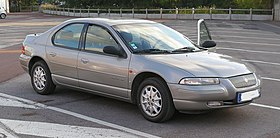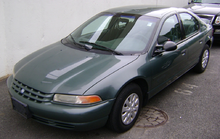Chrysler Cirrus
| Chrysler Cirrus | |
|---|---|
 | |
| Overview | |
| Manufacturer |
|
| Also called |
|
| Production | June 1994–2000 |
| Model years |
|
| Assembly | United States: Sterling Heights, Michigan (Sterling Heights Assembly) |
| Designer | Michael Santoro (1991) |
| Body and chassis | |
| Class | Mid-size car |
| Body style | 4-door notchback sedan |
| Layout | Transverse front-engine, front-wheel drive |
| Platform | Chrysler JA platform |
| Related | Chrysler Sebring convertible |
| Powertrain | |
| Engine | |
| Transmission |
|
| Dimensions | |
| Wheelbase | 108 in (2,743 mm) |
| Length | 186.0–186.7 in (4,724–4,742 mm) |
| Width | 71.0–71.7 in (1,803–1,821 mm) |
| Height | 54.1–54.4 in (1,374–1,382 mm) |
| Curb weight | 2,911–3,181 lb (1,320–1,443 kg) |
| Chronology | |
| Predecessor |
|
| Successor |
|
The Chrysler Cirrus is a mid-sized 4-door notchback sedan introduced by Chrysler motors for the 1995 model year. Built on the Chrysler JA platform, the 4-door notchback sedan joined Chrylser's roster of "Cloud Car" models drawing their names names from meteorological terms, including the mid-priced Dodge Stratus it was based on introduced at the same time, and the low-priced Plymouth Breeze variant a year later.
Design[edit]
Development of the Cirrus started in 1991, with the goal of creating an affordable, expressive looking, fun to drive vehicle that was still safe enough to transport an everyday family.[1]
Completely flaunting the latter core criterion, the concept show vehicle featured rear suicide doors and a 400 hp turbocharged 3.0-liter two stroke engine.[1] Both the concept and production model used the Chrysler Corporation's new cab-forward design, which was launched on the larger LH sedans in 1992. This three-box design was characterized by a large passenger cabin in proportion to comparatively short hood and trunk, highlighted by a long, dramatically slanted windshield and short overhangs. Pushing the wheels further to the corners of the body created a much larger cabin than most other similarly sized vehicles of that time.
The a four-door notchback sedan was designed with flowing lines with no distinct beginning or end, but almost resembled a two-box fastback.[1] Design work was done during 1991, with the final version moved on for production by 1992.
Features[edit]
The Cirrus was introduced for 1995 as replacement for the Chrysler LeBaron sedan. It was often compared to other smaller mid-size cars such as the Chevrolet Malibu, yet judged roomier than the Ford Contour by many magazines such as Consumer Reports. The exteriors of the Chrysler Cirrus, Dodge Stratus, and Plymouth Breeze were very similar, with the front fascia, rear bumper, taillights, and wheels being the main differences. The interiors had little variation between the three models; being almost identical, save for the name on the steering wheel, and a few available options. The fascias of each JA car corresponds with each brand's minivan offering, sharing headlights and grille designs.
All three variants of the platform were available with most of the same standard features: four-wheel independent suspension (double wishbone in the front with a multilink rear), air conditioning, tilt steering wheel,[2] and driver and front-passenger air bags and available options, such as the following: an optional four-speed automatic transmission (Autostick was not available on the Breeze), anti-lock brakes, cruise control, power windows, power door locks, power mirrors, sunroof. A five-speed manual was available with the 2.0 L. The 2.4 L was not offered in a manual because of its high torque and difficult drivability issues, mainly due to wheel spinning.
The Cirrus was originally available in two trim levels: the well-equipped base LX and the luxury LXi. Both models featured sporty, black twin-post side mirrors, fog lights, the same bodyside mouldings, chrome bumper accents, an automatic transmission and a low extending waterfall grille that was either chrome or body colored depending on color of the vehicle. The Cirrus was one of the first Chrysler vehicles to feature the rose medallion logo, which had not been used in 41 years.[3] From 1995 to 1997, the Cirrus was offered in two trim levels: the entry-level LX and the luxury LXi. The LX model was dropped for the 1998 model year, but returned in 2000 to compensate for the Plymouth Breeze that was discontinued early in the 2000 model year. It was replaced by the 2001 Dodge Stratus sedan.
Trim levels[edit]
- LX • 1995–1997; 2000
- LXi • 1995–2000
Trim Level Features[edit]
LX: The LX was the base Chrysler Cirrus trim level. It included the following standard equipment: a 2.4L Inline Four-Cylinder (I4) engine, a four-speed automatic transmission, black steel wheels with plastic wheel covers, an A/M-F/M stereo with cassette player and six speakers, air conditioning, full instrumentation, power windows and door locks, exterior color-keyed side mirrors and door handles, and premium cloth seats.
LXi: The LXi was the top-of-the-line Chrysler Cirrus trim level. It added the following equipment to the already well-equipped LX trim level: alloy wheels, a premium A/M-F/M stereo with cassette player and integrated CD changer controls, keyless entry, chrome accents, a premium front grille, and woodgrain interior trim.
Engines[edit]
Model year changes[edit]
- 1995: The all-new Chrysler Cirrus sedan is launched in the United States and Canada in late 1994.
- 1996: Rear headrests were added.
- 1997: The 4-cylinder engine was made standard in both models, with the V6 as an option. The interior gained a new center console with a storage compartment and integrated armrest.
- 1998: The 4-cylinder engine and the LX trim level were eliminated, leaving only V6 LXi models.
- 1999: For its fifth model year, the Cirrus received a redesigned open grille with Chrysler's new winged grille badge. Chrysler's Sentry Key system was a new option. Sentry Key disabled the ignition unless the proper key was inserted. Standard 15-inch (380 mm) wheel covers could be upgraded to new 15-inch (380 mm) alloy wheels. Cirrus was the only one of the JA "cloud cars" to receive any form of facelift over the course of its production.
- 2000: For its final model year, the 4-cylinder LX model returned to join the V6-powered LXi sedan. Previously optional rear child seat anchorages, aluminum wheels, and an 8-speaker AM/FM radio stereo were now listed as standard features. The last Chrysler Cirrus rolled off the assembly line on June 13, 2000.
Plymouth Breeze[edit]
The Plymouth Breeze was released in 1995 as a 1996 model. Although it did not match the sales of its predecessor, the Acclaim, the Breeze did manage to sell over 230,000 units and total production was greater than that of its Chrysler Cirrus sibling, which was produced for nearly two additional years.[4]
As part of Chrysler's new marketing strategy which addressed concerns that its brands were treading into each other's marketing territory, Plymouth, as Chrysler Corporation's low-price brand for essentially its entire existence, was to focus exclusively on value.[5] As a result, the Breeze (as well as the base model Stratus) filled the position as the entry-level JA car. Due to this, the Breeze lacked certain features including an available V6 engine, alloy wheels, leather interior, body-colored door handles, fog lights, and Chrysler's Autostick transmission, all of which were offered on the Stratus and Cirrus.[1][6]
The Plymouth Breeze came only as one basic model. Equipped similarly to a base model Dodge Stratus, the Breeze came standard with the 2.0 L I4 engine, five-speed manual transmission, 14-inch wheel covers, air conditioning, tilt steering wheel, AM/FM stereo, and driver and front-passenger air bags. The Breeze was also available with many options including a four-speed automatic transmission, 2.4 L four-cylinder engine (available with automatic transmission only), anti-lock brakes, cruise control, power windows, power door locks, power mirrors, cassette or CD player, and a power sunroof. Additionally, 1998 and 1999 Breezes offered an "Expresso Package" similar to the one available on the Voyager and Neon. "Expresso" content included special badging, unique wheel covers, upgraded audio system, and premium interior cloth in unique "Rhythm" pattern.[6] The Breeze was discontinued early in the 2000 model year,[1] as part of the Chrysler's phaseout of the Plymouth brand; the last Breeze rolled off the Sterling Heights Assembly line on January 7, 2000.
Trim levels[edit]
- base: 1996–2000
- Expresso: 1998–1999
Trim Level Features[edit]
Base: The Base was the least-expensive trim level of the Plymouth Breeze from 1994-1999, and the only available trim level for the Breeze's final year of production in 2000. The Base included the following standard equipment: a 2.0L Inline Four-Cylinder (I4) engine, a five-speed manual transmission, fifteen-inch black steel wheels with plastic wheel covers, an A/M-F/M stereo with four speakers, full instrumentation, air conditioning, cloth seats, and manual windows and door locks.
Expresso: The Expresso was the top-of-the-line trim level of the Plymouth Breeze, but was discontinued after 1999. The Expresso added the following equipment to the Base trim level: power windows and door locks, an A/M-F/M stereo with cassette player and six speakers, premium cloth seats, exterior color-keyed side mirrors and door handles, and a 2.4L Inline Four-Cylinder (I4) engine with a four-speed automatic transmission. An Expresso decal adorned both front doors, as well as the rear trunk lid.
Engines[edit]
Year-to-year changes[edit]
- 1996: Plymouth Breeze sedan is released.
- 1997: A new center console which included storage space, an integrated armrest, and rear-seat cupholders.
- 1998: The 2.4 L I4 is added as an option, and so is the Expresso trim level.
- 1999: Revised suspension tuning for 1999 which promised a smoother ride.
- 2000: Breeze production was halted early in 2000, due to the phaseout of the Plymouth brand name. Only a base model Breeze was available.
Dodge Stratus[edit]
The Dodge Stratus was introduced in February 1995, with two trims: base (later renamed SE for 2000), which came standard with the 2.0 L I4 or optional 2.4 L; and the ES, which came standard with the a 2.0 L from 1994–1997, and had a DOHC 2.4 L and a 2.5 L V6 as optional. In 1998 the 2.4 L was standard and the 2.5 L V6 was optional on the ES, and from 1999–2000, the 2.5 L V6 was the only engine on the ES model.
The Stratus directly replaced the high-volume Spirit and Dynasty (United States only) to favorable reviews, but lower sales.
Mexico: A turbocharged version of the Stratus was sold in Mexico, with the 2.4 L DOHC 4-cylinder engine and a 4-speed automatic transmission with AutoStick. This engine produced 168 hp (125 kW; 170 PS) at 5200 rpm and 216 pound force-feet (293 N⋅m) of torque at 2200 rpm.
In 2000, the Stratus was available for its last year of sales in Canada, with the Chrysler Sebring taking over as the company's only lower mid-size sedan - Dodge did not sell the equivalent version in Canada.
Chrysler Stratus[edit]
The Stratus was marketed as the Chrysler Stratus in markets that the Dodge name was not used; such as Europe, Argentina and Brazil. In Brazil, the Stratus had the same engines as the North American version but a higher ground clearance for the road conditions there. In Europe, only the 2.0 L 4-cylinder engine or the 2.5 L V6 engine were available. The European version also had chrome accent moldings along the doors and bumpers.
Year-to-year changes[edit]
- 1995: Stratus sedan is released.
- 1996: No changes
- 1997: A new center console which included storage space, an integrated armrest, and rear-seat cupholders.
- 1998: 2.4 L becomes standard on ES
- 1999: V6 engine becomes standard on ES
- 2000: Base trim renamed SE
Trim levels[edit]
- base 1995-1999
- SE 1999-2000
- ES 1995-2000
Trim Level Features[edit]
Base: The Base was the least expensive trim level of Stratus from 1995-1999. The Base was very well-equipped, with standard equipment such as: a 2.0L Inline Four-Cylinder (I4) engine, a five-speed manual transmission, fifteen-inch black steel wheels with plastic wheel covers, an A/M-F/M stereo with four speakers, air conditioning, manual windows and door locks, cloth seats, and a full instrument cluster.
SE: The SE was the least expensive trim level of Stratus in 2000. The SE included exactly the same standard equipment as the previously-base Base trim level of Stratus.
ES: The ES was the top-of-the-line trim level of Stratus from 1995-2000. The ES added the following equipment to the Base or SE trim levels: a 2.4L Inline Four-Cylinder (I4) engine, a four-speed automatic transmission, alloy wheels, a premium A/M-F/M stereo with cassette player and integrated CD changer controls with six speakers, power windows and door locks, keyless entry, a power-adjustable driver's seat, premium cloth seats, and exterior color-keyed side mirrors and door handles.
Engines[edit]
Accolades[edit]
- The Cirrus, Breeze, and Stratus were Motor Trend magazine's Car of the Year for 1995.[7]
- The Cirrus, Breeze, and Stratus were Car and Driver magazine's Ten Best list for 1996 and 1997.[8][9]
Production figures[edit]
Breeze[edit]
| Model Year | Sales |
|---|---|
| 1996 | 46,355 |
| 1997 | 70,549 |
| 1998 | 66,620 |
| 1999 | 47,911 |
| 2000 | 2,030 |
| Total | 233,465[10] |
References[edit]
- ^ Jump up to: a b c d e "1995-2000 Dodge Stratus, Plymouth Breeze, and Chrysler Cirrus". allpar. Retrieved 20 November 2015.
- ^ Old Cars Weekly Staff (2012). Standard Catalog of Chrysler 1914-2000. Krause Publications. ISBN 9781440232367.
- ^ Auto Editors of Consumer Guide (1 June 2007). "How Chrysler Works". HowStuffWorks.com. Retrieved 20 November 2015.
- ^ Auto Editors of Consumer Guide (2006). "Plymouth "Chrysler Production Figures"". Encyclopedia of American Cars. Publications International. pp. 280–281. ISBN 9781412713542.
- ^ Yates, Brock (1996). The Critical Path: Inventing an Automobile and Reinventing a Corporation "Showtime in St.Louis" p. 209–11. Little, Brown.
- ^ Jump up to: a b Daimler-Chrysler Corporation Factory Sales Brochure "1999 Plymouth lineup"
- ^ "1995 Chrysler Cirrus LXi - Car of the Year". Motor Trend. 1 January 1995. Retrieved 20 November 2015.
- ^ Csere, Csaba (January 1996). "1996 Chrysler Cirrus/Dodge Stratus 1996 10 Best Cars". Car & Driver. Retrieved 20 November 2015.
- ^ Csere, Csaba (January 1997). "1997 Chrysler Cirrus/Dodge Stratus/Plymouth Breeze 1997 10 Best Cars". Car & Driver. Retrieved 20 November 2015.
- ^ Encyclopedia of American Cars "Plymouth Production Figures" pp. 719.
External links[edit]
| Wikimedia Commons has media related to Chrysler Cirrus. |
- Chrysler Cirrus at the Internet Movie Cars Database
- Plymouth Breeze at the Internet Movie Cars Database
| show « previous — Chrysler car timeline, 1970–present
|
|---|
| show « previous — Plymouth road car timeline, 1970s–2001, United States market
|
|---|



